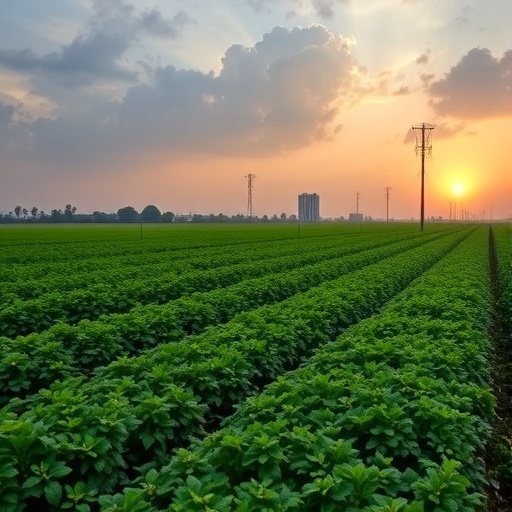Lahore, the vibrant heart of Pakistan’s Punjab province, is facing a daunting challenge as it grapples with deteriorating air quality. The agricultural sector, vital for the region’s economy and sustenance, may paradoxically be contributing significantly to the problem. New research published in the Environmental Science and Pollution Research journal details a comprehensive investigation into how agricultural sources influence air pollution levels in this densely populated city. By utilizing advanced modeling techniques provided by the Community Multiscale Air Quality (CMAQ) simulation framework, the study provides critical insights.
The research led by Abbasi, Fang, and Wang brings to light the multifaceted impact that various agricultural practices have on airborne contaminants. The team approached the study with a keen awareness of Lahore’s unique environmental conditions, marked by an increasingly urbanized landscape that intertwines with extensive agricultural activities. This duality of urban and agricultural sources complicates the local air quality scenario and necessitates a sophisticated analytical approach to elucidate the contributions of each sector.
CMAQ stands out in its role within this research, providing a platform that integrates atmospheric science and pollution dynamics with real-world agricultural practices. The authors utilized this advanced modeling tool to simulate how emissions from different agricultural activities, including fertilizer application and crop residue burning, interact with urban pollution sources. By inputting extensive data related to meteorological patterns, land use, and emission inventories, the model allowed researchers to visualize and quantify the synergistic effects of these emissions on local air quality.
One of the most alarming findings of the study indicates that specific agricultural practices are responsible for a significant uptick in particulate matter levels, which are known to pose severe health risks. Fine particulate matter (PM2.5), for instance, has been linked directly to respiratory ailments and cardiovascular diseases. As the researchers navigated through the CMAQ outputs, they discovered not only the temporal trends of air quality deterioration but also how spatial distributions varied throughout the city’s urban and agricultural areas.
The research highlights the urgent need for policymakers to consider agricultural practices in air quality management strategies. A crucial part of this discussion revolves around the implementation of better agricultural practices, which could mitigate their adverse effects on air quality. This comes at a time when Lahore, already infamous for its hazardous air pollution levels, struggles to maintain a balance between agricultural productivity and public health.
Moreover, the paper delves into the broader implications of air quality degradation in Lahore, stressing how it affects vulnerable populations, particularly children and the elderly. The interconnection between air pollution and socioeconomic factors implies that low-income families, who often live in the most polluted areas, are disproportionately affected. Tackling air quality issues thus becomes a multifaceted challenge, one that interlinks health, economics, and environmental sustainability.
The researchers also expand upon the role of government regulations and incentives in reshaping agricultural practices. Strengthening existing regulations on burning crop residues and encouraging sustainable fertilizer usage may be pivotal steps in reducing agricultural emissions. It becomes clear that the research underscores an intrinsic link between air quality management and agricultural policy.
Furthermore, the study does not shy away from advocating for community engagement. Involving farmers in discussions about the environmental impact of certain farming practices is essential to fostering a culture of sustainability. Educational programs can illuminate the detriments of traditional methods such as open burning while promoting alternative, eco-friendly practices that align with both agricultural prosperity and air quality improvements.
As the research suggests, collaboration between agricultural scientists, environmentalists, and policymakers is crucial. It paves the way for integrated approaches that can harness agricultural innovations to combat air pollution. By promoting precision farming techniques that utilize data-driven approaches, farmers could optimize their operations, thereby reducing emissions while maintaining yields.
The study’s findings could serve as a blueprint for similar cities facing the dichotomy of urban and agricultural pollution. As cities worldwide experience similar struggles, the integration of CMAQ-type simulations could enhance understanding and lead to action-oriented solutions. The potential for these models extends beyond Lahore, offering valuable insights applicable to regions across South Asia and beyond.
As Lahore stands at this crossroads, the importance of interdisciplinary research becomes glaringly evident. It drives home the point that sustainable development cannot merely focus on urban or rural sectors in isolation but must integrate efforts in both domains. The interplay between agricultural emissions and urban air quality must remain a focal point of environmental research and policy-making.
This rigorous examination of agricultural impacts on air quality presents myriad opportunities for future research. As more data emerges and methodologies become refined, scholars can further dissect the nuances between various agricultural practices and their specific contributions to air pollution. The story unfolding in Lahore is a call to action, not only for local stakeholders but for the global scientific community to recognize the urgent need for integrated environmental management practices.
In conclusion, the intricacies of air quality management necessitate an expansive approach that recognizes the crucial role of agriculture. While Lahore’s air quality presents a grave concern, the knowledge shed by Abbasi and colleagues offers hope and a path forward. With collaborative efforts, informed policy decisions, and a community interested in sustainable practices, there is potential for this bustling metropolis to overcome one of its most pressing challenges.
Subject of Research: Impact of agricultural sources on air quality in Lahore, Pakistan
Article Title: Effects of agricultural sources on air quality in Lahore, Pakistan, based on CMAQ simulation
Article References:
Abbasi, A., Fang, C., Wang, J. et al. Effects of agricultural sources on air quality in Lahore, Pakistan, based on CMAQ simulation.
Environ Sci Pollut Res (2025). https://doi.org/10.1007/s11356-025-37010-1
Image Credits: AI Generated
DOI:
Keywords: air quality, agricultural emissions, CMAQ simulation, Lahore, environmental policy, public health, particulate matter, sustainable farming practices.




